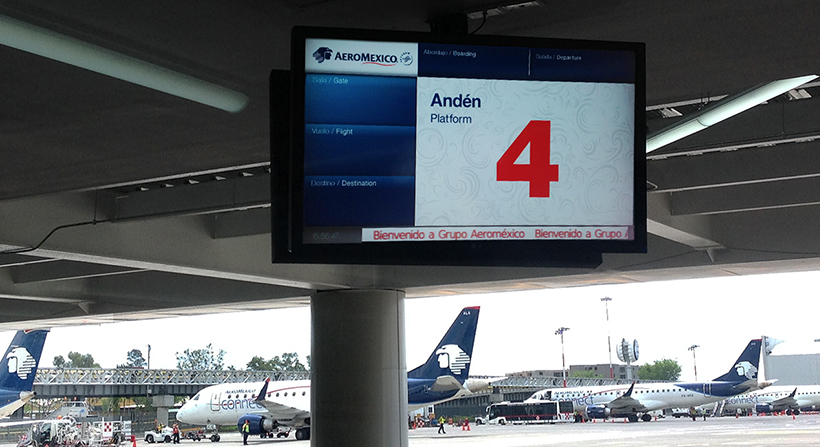
Digital signage at airports
<p style=”text-align: justify;”>In every large city, airports are a very active environment. Considering arrivals and departures, people interact, exchange ideas, communicate and receive information, as well.
The never ending waiting lines, very long waitingtimes and delays due to poor weather are some of the experiences suffered by those who amble there. Easing up boarding and arrival of passengers to all flights has become a paramount issue for airports, in order to improve the service given to all users.
How can they inform users directly, timely and promptly without causing any unnecessary movement? Digital Signage is an elemental tool that offers orientation and information to travelers, 24/7.
There are several solutions in Digital Signage that ease and improve both the dynamic and functioning of airports worldwide.
Some airports have special FIDS variants such as BIDS (Baggage Information and Delivery Service), or GIDS (Gate Information Delivery Service). Other airports use a generic term, such as PIDS (Passenger Information Delivery Service). Digital Signage is highly visible and essential in said areas since it offers all the necessary info in real time about air traffic control, segmented by areas, with the possibility to check connections to different sources of info that yields a timely updating about last minute changes.
The implementation of Wayfinding in airport terminals offers detailed info to visitors about their own location with maps and interactive navigational routes. Interactive kiosks allow a more customized attention to the user since it offers consultation and orientation modules that give detailed info about flights, locations, etc. Both implementations can include advertising content that generates income to brands that will pay to have their spaces shown in the maps and directories.
Another trending in airport signage is the implementation of video walls, since they can be customized to either change the content or blend with several elements to lure global advertisers, hence boosting sales of advertising concessions to tenants of the airport. By blending the content with advertising, video walls can help airports to create an additional flow of economic income.
More and more airports are incorporating Digital Signage to their spaces; the dynamic and updating communication at an airport is paramount since it keeps users duly updated regarding flight info, accurate and updated. By combining all these factors with the capacity to control all Digital Signage from a central location, it will come as no surprise that the increase of digital signage installations becomes a trending issue for both workers and travelers.
</p>
En toda gran urbe, los aeropuertos representan un lugar público de gran actividad. Entre llegadas y salidas de vuelo, las personas se relacionan, intercambian ideas, se comunican y paralelamente, reciben información.
Las filas interminables, esperas muy largas y retrasos ocasionados por el mal tiempo, son algunas de las circunstancias que viven quienes por ahí circulan. Facilitar el abordaje y arribo de los pasajeros a los diferentes vuelos se ha convertido en una prioridad para los aeropuertos, a fin de mejorar el servicio proporcionado a los usuarios.
¿Cómo informar a los usuarios directa, oportuna y eficazmente sin provocar algún movimiento innecesario? La Señalización Digital es una herramienta elemental que brinda orientación e información a los viajeros las veinticuatro horas, 365 días al año.
Existen diversas soluciones en Señalización Digital que facilitan y mejoran la dinámica y el funcionamiento de los aeropuertos en todo el mundo.
Algunos aeropuertos tienen variantes especiales de FIDS como Sistemas de Información de Equipaje (BIDS), o Sistema de Información de la Puerta (GIDS). Otros aeropuertos usan un término genérico como el Sistema de Información de Pasajeros (PIDS). La Señalización Digital es altamente visible y esencial en estas zonas, ya que brinda la información necesaria en tiempo real acerca del control aéreo, segmentada por áreas, con la posibilidad de conexión a diferentes fuentes de información que permiten la actualización oportuna de cambios de último momento.
La implementación de Wayfinding en centrales aeroportuarias, proporciona información detallada a los visitantes sobre su ubicación mediante mapas y rutas de navegación interactivas. Los Kioscos interactivos permiten una atención más personalizada al usuario, ya que ofrecen módulos de consulta y orientación que proporcionan información detallada de vuelos, ubicaciones, etc. Ambas implementaciones pueden contar con contenido publicitario que generen ingresos a través de marcas que pagarán por tener sus espacios al por menor, promovidos en los mapas y directorios.
Otra tendencia en la señalización de aeropuertos es la implementación de videowalls, ya que pueden personalizarse para cambiar el contenido o mezclarse con varios elementos para atraer a los anunciantes globales, impulsando las ventas de concesiones de anuncios a inquilinos del aeropuerto. Al mezclar el contenido con la publicidad, los videowalls pueden ayudar a los aeropuertos a crear un flujo adicional de ingresos económicos.
Cada vez más aeropuertos estarán buscando incorporar la Señalización Digital a sus espacios; la comunicación dinámica y actualizable en un aeropuerto es crucial, ya que mantiene al tanto a los usuarios de la información del vuelo, la cual es exacta y actualizada. Al combinar estos factores con la capacidad de controlar toda la Señalización Digital desde una ubicación central, no será de extrañar que el aumento de las instalaciones de señalización digital sea una tendencia para el disfrute de los trabajadores y viajeros.


